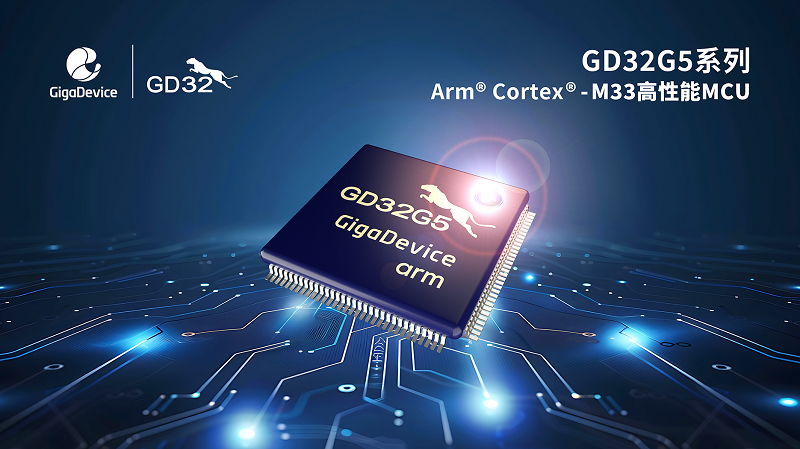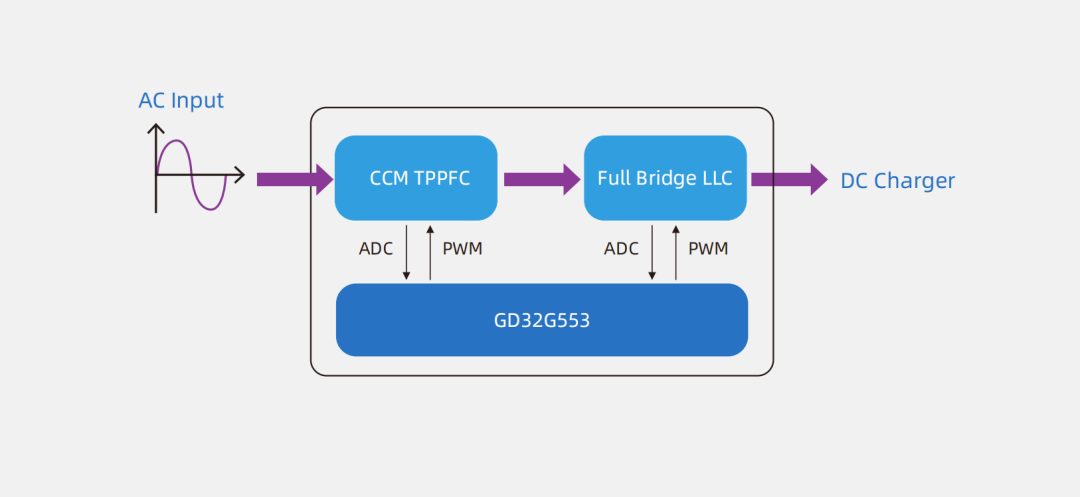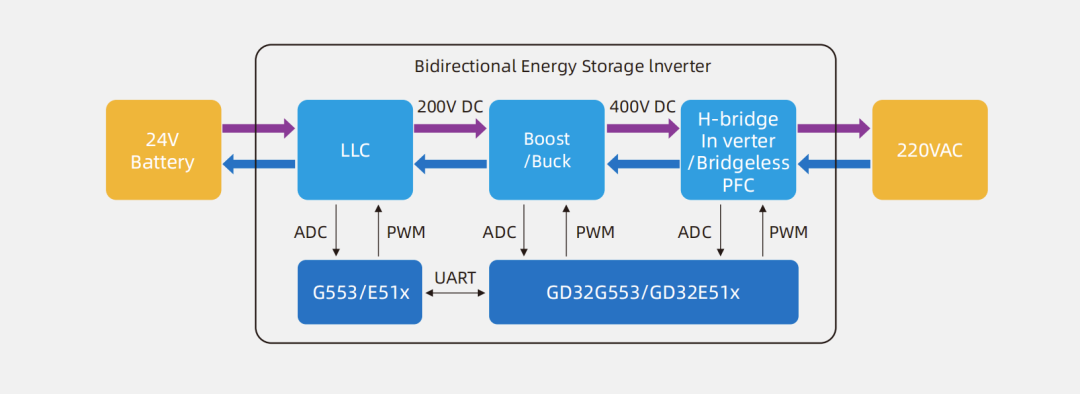Whether it is the rapidly emerging digital energy sector, the continuously expanding applications of motor control, or the rapidly developing optical communication, these fields are undergoing a transformation deeply integrated with cutting-edge technologies such as big data analysis, cloud computing, and artificial intelligence (AI). This integration not only drives a massive expansion of technological boundaries but also triggers a rapid increase in the demand for intelligent solutions.In the face of these increasingly complex challenges in the industry, MCUs have become the key to breaking through. MCUs are not only the core components for achieving system intelligence but also play an indispensable role in enhancing energy efficiency, optimizing performance, and ensuring safety. By integrating advanced algorithms and functional modules, MCUs can respond to and process complex data in real-time, ensuring that various systems operate efficiently and stably. The GD32G5 series of high-performance MCUs launched by GigaDevice, with its powerful computing capabilities, rich peripherals, and comprehensive security mechanisms, provides solid technical support to meet these challenges, helping various industries achieve efficiency optimization, performance enhancement, and stable operation.High-Performance, High-Security MCUs are Key to Applications in Three Major FieldsThe digital energy system, which combines IoT, big data analysis, cloud computing, and AI, aims to improve energy efficiency, reduce waste, and promote the integration of renewable energy. In this ecosystem, MCUs ensure efficient operation by precisely monitoring power parameters such as voltage and current, and by adjusting system settings in real-time. Additionally, MCUs support multiple communication protocols, enabling seamless data exchange between devices and promoting the effective integration of distributed energy resources.For motor control, modern MCUs integrate functions such as PWM control and high-speed ADCs, simplifying system design and reducing the need for external components. Furthermore, MCUs can process complex control algorithms in real-time, ensuring that motors operate smoothly under various load conditions, thereby improving overall performance.In the field of optical communication, the role of MCUs is equally significant. Particularly in optical modules, MCUs are responsible for real-time monitoring of critical parameters such as temperature, voltage, current, and optical power, ensuring stable operation of the optical modules. At the same time, MCUs support remote management and diagnostic functions, enhancing the operational efficiency and security of networks. To meet the growing demand for high-performance MCUs in these three fields, GigaDevice has launched the GD32G5 series of high-performance MCUs. The most notable feature of this series is its powerful computing capabilities, utilizing the Arm® Cortex®-M33 core with a maximum frequency of 216MHz, built-in advanced DSP hardware accelerators, single-precision floating-point units (FPU), hardware trigonometric function accelerators (TMU), and support for various hardware acceleration units. These features significantly enhance data processing speed and complex computation capabilities.Memory resources are also a key factor determining MCU performance. The GD32G5 series MCUs are equipped with 256KB to 512KB of embedded Flash, support Flash dual bank functionality, and have 128KB of SRAM, along with high-speed cache space, further enhancing core processing performance.In terms of peripheral integration, the GD32G5 series also performs excellently, with a rich array of interfaces and functional modules to adapt to diverse application scenarios. Notably, it features comprehensive security mechanisms, including secure over-the-air (OTA) updates, secure boot, secure debugging, and secure upgrades, providing robust guarantees for data integrity and security during communication. The GD32G5 product series supports the IEC 61508 SIL2 functional safety standard, offering a complete Safety Package, including Safety Manual, FMEDA, and self-test libraries, to assist industrial applications in being safer and more reliable.The Core of Efficiency Optimization in Digital EnergyIn the digital energy sector, power control is a key application direction for MCUs. In this field, the GD32G5 series MCUs demonstrate significant advantages, particularly in the following two key technologies:First is waveform control. Taking the GD32G553 from this series as an example, it features a high-precision timer (HRTIM) that supports 16-bit 16-channel configurations, capable of meeting various complex topologies; additionally, it supports 10 external event inputs and 8 fault input channels, allowing for flexible waveform generation modes across multiple topologies.The second is precise sensing. The GD32G553 supports 4 12-bit ADCs with a sampling rate of up to 5.3MSPS, with up to 42 channels, efficiently collecting and processing signals from various sensors. Moreover, the GD32G553 features fast system protection and auxiliary waveform generation capabilities. It is equipped with 8 comparators (CMP) with a propagation delay of only 15.8ns and programmable hysteresis from 0-63mV, enabling rapid response to fault inputs or external events. Additionally, the GD32G553 includes 4 1Msps/15Msps 12-bit DACs, supporting up to 8 channels, which can work with HRTIM to implement ramp compensation and other functions.
To meet the growing demand for high-performance MCUs in these three fields, GigaDevice has launched the GD32G5 series of high-performance MCUs. The most notable feature of this series is its powerful computing capabilities, utilizing the Arm® Cortex®-M33 core with a maximum frequency of 216MHz, built-in advanced DSP hardware accelerators, single-precision floating-point units (FPU), hardware trigonometric function accelerators (TMU), and support for various hardware acceleration units. These features significantly enhance data processing speed and complex computation capabilities.Memory resources are also a key factor determining MCU performance. The GD32G5 series MCUs are equipped with 256KB to 512KB of embedded Flash, support Flash dual bank functionality, and have 128KB of SRAM, along with high-speed cache space, further enhancing core processing performance.In terms of peripheral integration, the GD32G5 series also performs excellently, with a rich array of interfaces and functional modules to adapt to diverse application scenarios. Notably, it features comprehensive security mechanisms, including secure over-the-air (OTA) updates, secure boot, secure debugging, and secure upgrades, providing robust guarantees for data integrity and security during communication. The GD32G5 product series supports the IEC 61508 SIL2 functional safety standard, offering a complete Safety Package, including Safety Manual, FMEDA, and self-test libraries, to assist industrial applications in being safer and more reliable.The Core of Efficiency Optimization in Digital EnergyIn the digital energy sector, power control is a key application direction for MCUs. In this field, the GD32G5 series MCUs demonstrate significant advantages, particularly in the following two key technologies:First is waveform control. Taking the GD32G553 from this series as an example, it features a high-precision timer (HRTIM) that supports 16-bit 16-channel configurations, capable of meeting various complex topologies; additionally, it supports 10 external event inputs and 8 fault input channels, allowing for flexible waveform generation modes across multiple topologies.The second is precise sensing. The GD32G553 supports 4 12-bit ADCs with a sampling rate of up to 5.3MSPS, with up to 42 channels, efficiently collecting and processing signals from various sensors. Moreover, the GD32G553 features fast system protection and auxiliary waveform generation capabilities. It is equipped with 8 comparators (CMP) with a propagation delay of only 15.8ns and programmable hysteresis from 0-63mV, enabling rapid response to fault inputs or external events. Additionally, the GD32G553 includes 4 1Msps/15Msps 12-bit DACs, supporting up to 8 channels, which can work with HRTIM to implement ramp compensation and other functions. Figure 1: 3.5kW DC Charging Scheme TopologyGigaDevice has constructed two application schemes centered around the GD32G553. The first is a 3.5kW DC charging scheme, which uses a single GD32G553 series MCU to control a two-stage high-efficiency switch-mode power supply topology, including a front-end single-phase totem pole PFC and a back-end full-bridge LLC. The input voltage for this scheme is 220V (±10%)/50Hz, with a maximum input current of 17A; the output voltage ranges from 250VDC to 450VDC, supporting trickle, constant current, and constant voltage charging modes; the PFC switching frequency is 70kHz, and the LLC switching frequency ranges from 94kHz to 300kHz.This scheme achieves a peak system efficiency of 96.2%, with a power factor (PF) of 0.999 and a total harmonic distortion (THD) of 2.7%. Under full-load constant current charging, the system efficiency is 95.6%, with a PF of 0.999 and a THD of 2.5%. To ensure system safety and reliability, this scheme is equipped with various software and hardware protection features, including overcurrent protection (OCP), short-circuit protection (SCP), overvoltage protection (OVP), over-temperature protection (OTP), current balance control (CBC), and desaturation protection (DESAT).
Figure 1: 3.5kW DC Charging Scheme TopologyGigaDevice has constructed two application schemes centered around the GD32G553. The first is a 3.5kW DC charging scheme, which uses a single GD32G553 series MCU to control a two-stage high-efficiency switch-mode power supply topology, including a front-end single-phase totem pole PFC and a back-end full-bridge LLC. The input voltage for this scheme is 220V (±10%)/50Hz, with a maximum input current of 17A; the output voltage ranges from 250VDC to 450VDC, supporting trickle, constant current, and constant voltage charging modes; the PFC switching frequency is 70kHz, and the LLC switching frequency ranges from 94kHz to 300kHz.This scheme achieves a peak system efficiency of 96.2%, with a power factor (PF) of 0.999 and a total harmonic distortion (THD) of 2.7%. Under full-load constant current charging, the system efficiency is 95.6%, with a PF of 0.999 and a THD of 2.5%. To ensure system safety and reliability, this scheme is equipped with various software and hardware protection features, including overcurrent protection (OCP), short-circuit protection (SCP), overvoltage protection (OVP), over-temperature protection (OTP), current balance control (CBC), and desaturation protection (DESAT). Figure 2: Portable Bidirectional Energy Storage Inverter Scheme TopologyThe second application is a portable bidirectional energy storage inverter scheme based on the GD32G5 series/GD32E5 series, capable of achieving off-grid discharging and grid-connected charging functions. This scheme controls a three-stage architecture (LLC + Buck/Boost + Inverter/PFC) using two GD32G5 series/GD32E5 series MCUs, ensuring high efficiency and stability of the system. The LLC switching frequency is 100kHz, while the switching frequencies for the Boost/Buck and inverter/PFC sections are both 20kHz; the internal comparator implements overcurrent and overvoltage protection, reducing reliance on external hardware circuits and simplifying system design; the ADC oversampling technology used enables more precise average current control, while the overvoltage, overcurrent, and overtemperature protection mechanisms ensure safe operation of the system under various working conditions.Enhancing Motor Control Performance and EfficiencyFrom small household appliances to electric vehicles, the application of motors is ubiquitous. However, motor control imposes strict requirements on MCUs, including efficient processing capabilities, precise real-time control, and a rich set of peripheral interfaces. Specifically, MCUs need to support fast and accurate PWM signal generation to ensure smooth motor operation, be equipped with high-resolution ADCs for real-time monitoring of current and voltage, and have sufficient memory space to run complex control algorithms. Additionally, integrated safety mechanisms and diverse communication interfaces are crucial for ensuring system stability and connectivity.The GD32G553 meets these challenges perfectly with its outstanding configuration. First, the computing power of this MCU has been significantly enhanced, allowing for more efficient processing of complex motor control algorithms. Second, it provides a wealth of on-chip resources, including four 12-bit ADCs, eight comparators, and one high-performance digital filter (HPDF), which supports 8-channel/4-filter configurations and can interface with external Σ-Δ modulators, suitable for inverters and low-end servo applications. Finally, the GD32G553 is equipped with three 16-bit advanced timers, supporting 8-channel/4-pair complementary modes, suitable for controlling two-phase four-wire stepper motors; its composite mode supports single-resistor sampling and dual sampling of bus power, achieving precise control of the stepper motor’s fast and slow decay mixed mode, further enhancing the flexibility and efficiency of motor control.The GD32G553 not only meets the stringent performance requirements for motor control but also demonstrates significant advantages in functional richness and application adaptability, meeting the complex motor control needs across various fields.The Key to Stable Operation of Optical ModulesUnlike general-purpose MCUs, optical modules have stricter standards for their dedicated MCUs in terms of chip size, analog function integration, and reliability. GigaDevice has comprehensively configured the GD32G553 to meet the challenges of optical modules.The GD32G553 features flexible memory space. Its 512KB Flash memory supports dual bank design, allowing for non-volatile upgrades, ensuring data security and durability; the 128KB SRAM meets the SRAM requirements of optical modules over 800G (greater than 64KB), satisfying the data processing needs of high-performance optical modules.The GD32G553 integrates a rich set of analog and digital resources, making it a significant advantage for its suitability in optical module applications. It features four 12-bit ADCs with a maximum sampling rate of 5.3Msps and supports up to 42 channels. Through multiple ADC interleaved sampling techniques, the GD32G553 can achieve sampling rates of up to 10M, perfectly meeting the demands for high precision and high-speed sampling. Additionally, the GD32G553 is equipped with four 12-bit DACs, with four channels supporting external output, providing highly flexible analog signal output capabilities suitable for various application scenarios.To facilitate system integration and debugging, the GD32G553 offers four I2C interfaces, supporting 1MHz Fast Mode Plus (Fm+), ensuring efficient communication with host computers.The design of the GD32G553 fully considers the needs of miniaturized packages for optical modules such as SFP-DD/QSFP-DD, supporting WLCSP packaging, making it very suitable for high-density deployments and space-constrained application scenarios. This feature allows the GD32G553 to save circuit board space significantly while ensuring performance, enhancing system integration.To accelerate the development process for users, GigaDevice provides a free development environment, GD32 Embedded Builder IDE, debugging download tools GD-LINK, and a multi-in-one programming tool GD32 All-In-One Programmer for the new GD32G5 series high-performance microcontrollers. Additionally, industry-leading embedded tool vendors such as Arm® KEIL, IAR, and SEGGER will provide comprehensive support for the new GD32G5 products, including development compilation and trace debugging tools.
Figure 2: Portable Bidirectional Energy Storage Inverter Scheme TopologyThe second application is a portable bidirectional energy storage inverter scheme based on the GD32G5 series/GD32E5 series, capable of achieving off-grid discharging and grid-connected charging functions. This scheme controls a three-stage architecture (LLC + Buck/Boost + Inverter/PFC) using two GD32G5 series/GD32E5 series MCUs, ensuring high efficiency and stability of the system. The LLC switching frequency is 100kHz, while the switching frequencies for the Boost/Buck and inverter/PFC sections are both 20kHz; the internal comparator implements overcurrent and overvoltage protection, reducing reliance on external hardware circuits and simplifying system design; the ADC oversampling technology used enables more precise average current control, while the overvoltage, overcurrent, and overtemperature protection mechanisms ensure safe operation of the system under various working conditions.Enhancing Motor Control Performance and EfficiencyFrom small household appliances to electric vehicles, the application of motors is ubiquitous. However, motor control imposes strict requirements on MCUs, including efficient processing capabilities, precise real-time control, and a rich set of peripheral interfaces. Specifically, MCUs need to support fast and accurate PWM signal generation to ensure smooth motor operation, be equipped with high-resolution ADCs for real-time monitoring of current and voltage, and have sufficient memory space to run complex control algorithms. Additionally, integrated safety mechanisms and diverse communication interfaces are crucial for ensuring system stability and connectivity.The GD32G553 meets these challenges perfectly with its outstanding configuration. First, the computing power of this MCU has been significantly enhanced, allowing for more efficient processing of complex motor control algorithms. Second, it provides a wealth of on-chip resources, including four 12-bit ADCs, eight comparators, and one high-performance digital filter (HPDF), which supports 8-channel/4-filter configurations and can interface with external Σ-Δ modulators, suitable for inverters and low-end servo applications. Finally, the GD32G553 is equipped with three 16-bit advanced timers, supporting 8-channel/4-pair complementary modes, suitable for controlling two-phase four-wire stepper motors; its composite mode supports single-resistor sampling and dual sampling of bus power, achieving precise control of the stepper motor’s fast and slow decay mixed mode, further enhancing the flexibility and efficiency of motor control.The GD32G553 not only meets the stringent performance requirements for motor control but also demonstrates significant advantages in functional richness and application adaptability, meeting the complex motor control needs across various fields.The Key to Stable Operation of Optical ModulesUnlike general-purpose MCUs, optical modules have stricter standards for their dedicated MCUs in terms of chip size, analog function integration, and reliability. GigaDevice has comprehensively configured the GD32G553 to meet the challenges of optical modules.The GD32G553 features flexible memory space. Its 512KB Flash memory supports dual bank design, allowing for non-volatile upgrades, ensuring data security and durability; the 128KB SRAM meets the SRAM requirements of optical modules over 800G (greater than 64KB), satisfying the data processing needs of high-performance optical modules.The GD32G553 integrates a rich set of analog and digital resources, making it a significant advantage for its suitability in optical module applications. It features four 12-bit ADCs with a maximum sampling rate of 5.3Msps and supports up to 42 channels. Through multiple ADC interleaved sampling techniques, the GD32G553 can achieve sampling rates of up to 10M, perfectly meeting the demands for high precision and high-speed sampling. Additionally, the GD32G553 is equipped with four 12-bit DACs, with four channels supporting external output, providing highly flexible analog signal output capabilities suitable for various application scenarios.To facilitate system integration and debugging, the GD32G553 offers four I2C interfaces, supporting 1MHz Fast Mode Plus (Fm+), ensuring efficient communication with host computers.The design of the GD32G553 fully considers the needs of miniaturized packages for optical modules such as SFP-DD/QSFP-DD, supporting WLCSP packaging, making it very suitable for high-density deployments and space-constrained application scenarios. This feature allows the GD32G553 to save circuit board space significantly while ensuring performance, enhancing system integration.To accelerate the development process for users, GigaDevice provides a free development environment, GD32 Embedded Builder IDE, debugging download tools GD-LINK, and a multi-in-one programming tool GD32 All-In-One Programmer for the new GD32G5 series high-performance microcontrollers. Additionally, industry-leading embedded tool vendors such as Arm® KEIL, IAR, and SEGGER will provide comprehensive support for the new GD32G5 products, including development compilation and trace debugging tools.